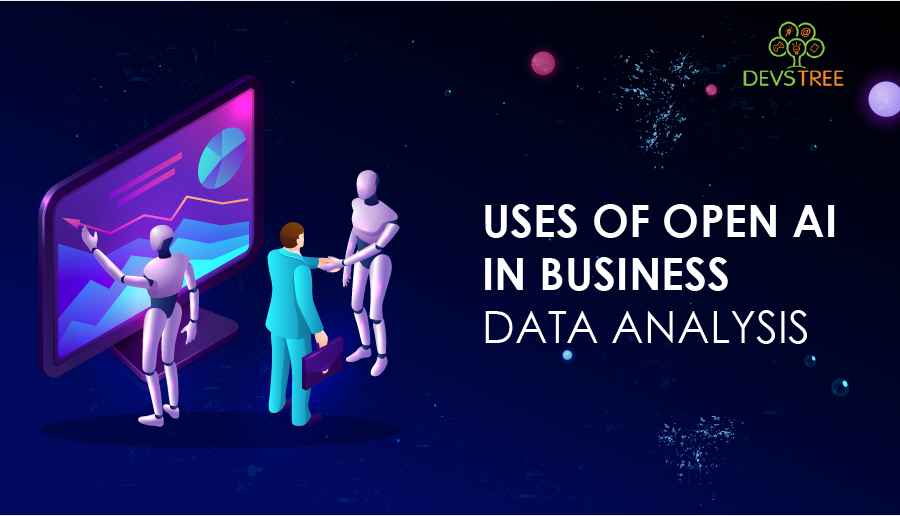As technology continues to develop at a rapid pace, businesses are finding new and innovative ways to analyze and use data to make smarter decisions. One of the most exciting and talked-about technologies in this space is OpenAI. OpenAI is an artificial intelligence research lab that has developed several cutting-edge tools for language processing, image recognition, and data analysis.
With OpenAI’s data analysis tools, businesses can now harness the power of machine learning to make sense of large datasets and uncover insights that were previously impossible. In this blog post, we will explore five ways businesses can use OpenAI for data analysis to improve their decision-making processes and drive success.
Read on to discover the five ways to use OpenAI for data analysis in your business!
OpenAI for Business Data Analysis in These 5 Ways:
Here are the five ways businesses can use OpenAI for data analysis in more detail, with examples:
Sentiment Analysis: OpenAI can help businesses gain insights into customer sentiment and attitudes about their brand. By analyzing customer reviews and social media data, OpenAI can identify patterns in customer feedback and provide insights that help businesses understand their customers’ needs and preferences. For example, OpenAI’s machine learning algorithms can identify positive and negative sentiments in social media responses, providing businesses with a better understanding of their brand perception.
In short, OpenAI
- Provides businesses insights into customer feedback and sentiment.
- Identify emerging issues that may require attention
- Keep track of brand reputation and perception
- Improve customer communications and support.
Customer Analytics: One key area where OpenAI can be especially useful is customer analytics. By analyzing customer feedback and trends through natural language processing (NLP), businesses can get a better understanding of what their customers are thinking, what they like and dislike, and how they are responding to new products and services.
For example, OpenAI’s GPT-3 language generation model can be used to generate natural-sounding responses to customer reviews, making the process more efficient and accurate.
In short, OpenAI
- Can provide a better understanding of customer preferences, opinions and feedback for businesses.
- Can improve the customer experience by identifying and addressing issues and concerns.
- Can help businesses make data-driven improvements to their product or service offerings.
- Can increase customer loyalty by providing more personalized and tailored experiences.
Forecasting: OpenAI can also be used for forecasting, enabling businesses to predict future trends and anticipate changes in their industry. By analyzing historical data and identifying patterns, businesses can use OpenAI to predict sales trends, demand for particular products, and stock prices. This can provide vital insights that help businesses stay ahead of the competition and plan for the future.
In short, OpenAI
- Enable businesses to anticipate future trends and stay ahead of the competition
- Can help businesses make strategic decisions about new product or service offerings
- Can help optimize inventory management and supply chain operations
- Reduce uncertainty and risk associated with decision-making.
Process Optimization: OpenAI can also help businesses optimize their processes and operations to become more efficient and reduce costs. By analyzing data from various sources, OpenAI can identify patterns and insights that can inform smart decision-making.
For example, OpenAI’s reinforcement learning algorithms can identify the most effective strategies for optimizing production lines, reducing the time it takes for certain tasks, and preventing equipment breakdown.
In general, OpenAI
- Can do identification of inefficiencies for process optimization
- Improves overall productivity and efficiency
- Helps reduce costs and resource wastage
- Better resource allocation
Risk Analysis: Risk analysis is another area where OpenAI can be useful. OpenAI’s powerful machine learning algorithms and predictive analytics can assist firms in identifying possible dangers and taking proactive steps to mitigate them. By analyzing historical data and identifying trends, businesses can better anticipate and prepare for various risks, such as financial loss, security breaches, and reputational damage.
In short, OpenAI
- Can help businesses identify potential risks proactively
- Reduces the likelihood of catastrophic risks and their impact on businesses
- Reduce financial and reputational damage
- Improve the long-term sustainability of the business.
Let’s Utilize OpenAI API for Business Data Analysis:
Businesses can harness the power of OpenAI and its API to add value to their data analysis processes. OpenAI provides a range of APIs, including Natural Language Processing (NLP), GPT-3, and computer vision, that can easily integrate with business data analytics tools, platforms and techniques.
By utilizing OpenAI APIs in business data analysis, you can:
- Enhance data processing and analysis accuracy
- Accelerate insights discovery
- Improve decision-making
- Generate predictive models
- Automate tedious tasks
Bottom Line:
In conclusion, utilizing OpenAI API for business data analysis can significantly improve the accuracy, efficiency and cost-effectiveness of the process. GPT-3 API is useful for summarizing textual data, generating new texts and automating certain tasks.
OpenAI Vision API can be utilized for image recognition, while Data Generation API can provide synthetic data for confidential, ethical and efficient analysis. It is essential to choose the appropriate API for specific business needs and consider the ethical, privacy, and security implications in the data analysis process.

